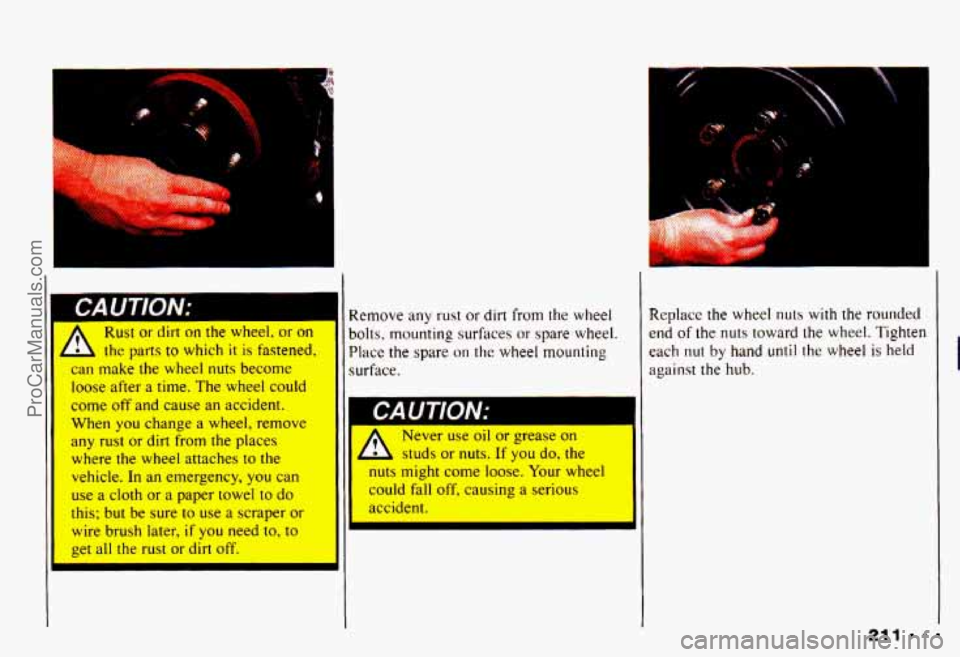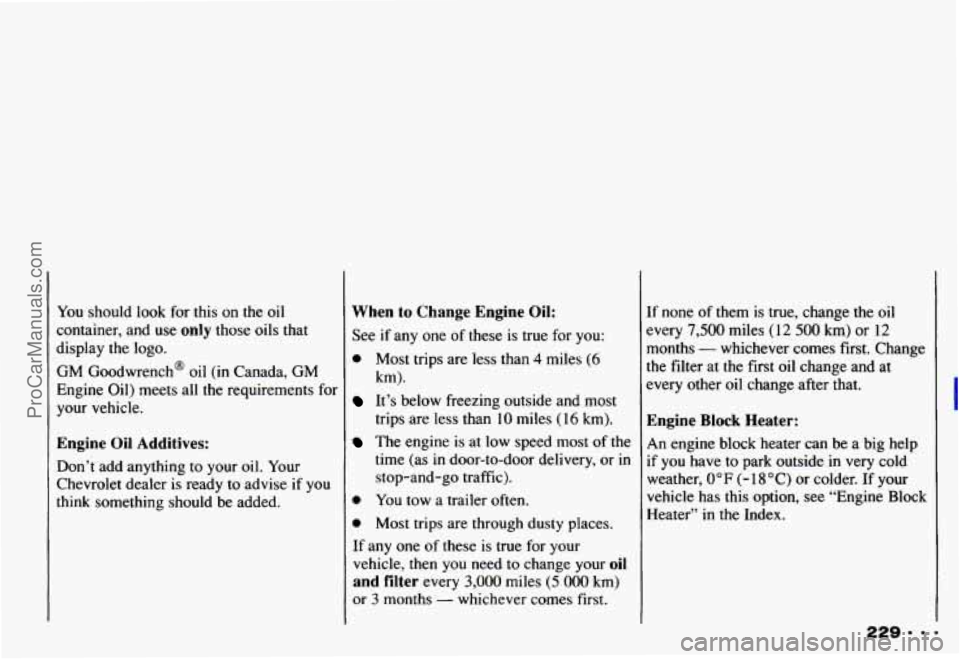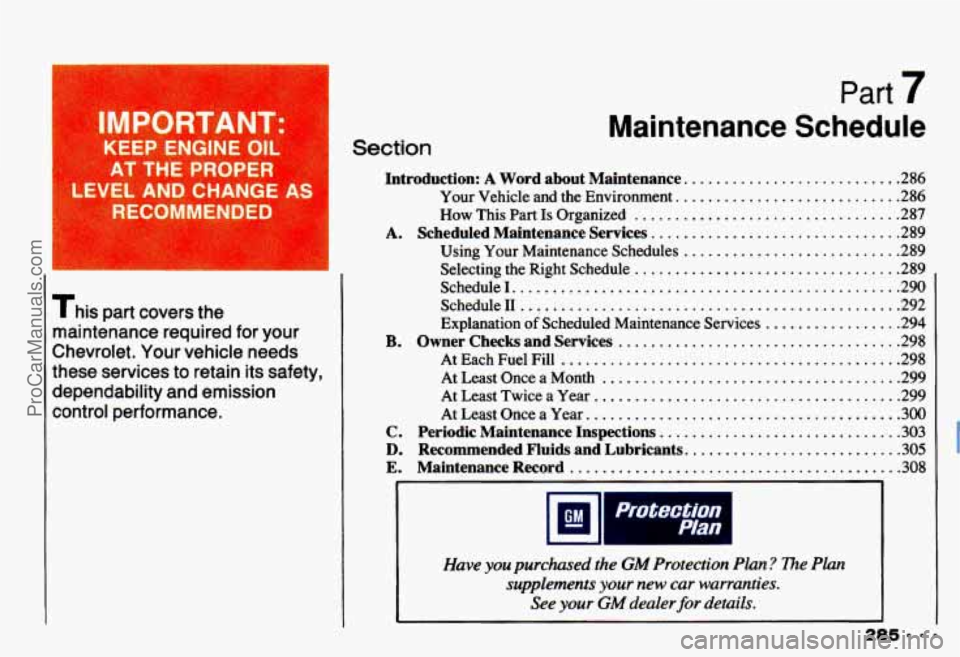1993 CHEVROLET CAMARO oil change
[x] Cancel search: oil changePage 215 of 358

I
A Rust or dirt on the wheel, or on
the parts to which it is fastened,
can make the wheel nuts become
loose after a time. The wheel could
come off and cause an accident.
When you change a wheel, remove
any rust or dirt from the places
where the wheel attaches to the
vehicle. In an emergency, you can
use a cloth or a paper towel to do
this; but be sure to use a scraper or
wire brush later, if you need to, to
get all the rust or dirt off.
I
I
1
1
!
I
I
Remove any rust or dirt from the wheel
3olts, mounting surfaces or spare wheel.
Place the spare on the wheel mounting
surfxe.
A
Never use oil or grease on
studs or nuts. If you do, the
nuts might come loose. Your wheel
could
fall off, causing a serious
accident.
i
Replace the wheel nuts with the roundec-1
end of the nuts toward the wheel. Tighten
each nut by hand until the wheel is held
against the hub.
211
ProCarManuals.com
Page 233 of 358

You should look for this on the oil
container, and use
only those oils that
display the logo.
GM Goodwrench@
oil (in Canada, GM
Engine Oil) meets all
the requirements for
your vehicle.
Engine Oil Additives:
Don’t add anything to your oil. Your
Chevrolet dealer is ready
to advise if you
think something should be added.
When to Change Engine Oil:
See if any one of these is true for you:
0 Most trips are less than 4 miles (6
km).
It’s below freezing outside and most
trips are less than
10 miles (16 km).
The engine is at low speed most of the
time (as
in door-to-door delivery, or in
stop-and-go traffic).
0 You tow a trailer often.
0 Most trips are through dusty places.
If any one of these is true for your
vehicle, then you need to change your
oil
and filter every 3,000 miles (5 000 km)
or 3 months - whichever comes first. If none
of them is true, change the oil
every
7,500 miles (12 500 km) or 12
months - whichever comes first. Change
the filter at the first oil change and at
every other
oil change after that.
Engine Block Heater:
An engine block heater can be a big help
if you have to park outside in very cold
weather,
0 OF (- 1 8 O C) or colder. If your
vehicle has this option, see “Engine Block
Heater’’
in the Index.
ProCarManuals.com
Page 234 of 358

Service & Appearance Care
I What to Do with Used Oil:
Us& engine oil contains things
- L that have mused skin cancer in
laboratory animals. Don’t let used
oil stay on your skin for very long.
Clean your skin and nails with soap
and water, or a good hand cleaner.
Wash or properly throw away
clothing or rags containing used
engine oil.
I
Used oil can be a real threat to the
environment.
If you change your own oil,
be sure to drain all free-flowing oil from the filter before disposal. Don’t ever
dispose
of oil by putting it in the trash,
pouring it on the ground, into sewers, or into streams or bodies
of water. Instead,
recycle it by taking it to a place that
collects used oil. If you have a problem
properly disposing of your used oil, ask
your dealer, a service station
or a local
recycling center for help.
air Cleaner 3.4L L32 (Code S)
tefer to the Maintenance Schedule to
letermine when to replace the air filter.
iee “Scheduled Maintenance Services’’ in
he Index.
... 230
ProCarManuals.com
Page 237 of 358

Automatic Transmission Fluid
When to Check and Change:
A good time to check your automatic
transmission fluid level is when the
engine oil is changed. Refer
to the
Maintenance Schedule
to determine when
to change your fluid. See “Scheduled
Maintenance Services” in the Index.
How to Check:
Because this operation can be a little
difficult, you may choose to have this
done at a Chevrolet dealership Service
Department.
If you do it yourself, be sure to follow all
the instructions here,
or you could get a
false reading
on the dipstick. damage
your transmission.
Too
much can mean that some of thr
fluid could come
out and fall on hc
~.: engine parts, starting a fire. Be sure
to get an accurate reading if you ~“* check your transmission fluid. ~, \- ~
%it at least 30 minutes before checking
he transmission fluid level
if you have
>een driving:
D When outside temperatures are above
At high speed for quite a while.
0 In heavy traffic - especially in hot
While pulling a trailer.
90°F (32°C).
weather. To
get the right reading, the fluid should
be at normal operating temperature,
which is 180°F to 200°F
(82°C to 93°C).
To check transmission fluid hot: Get
the vehicle warmed up by driving
about
15 miles (24 km) when outside
temperatures are above
50°F (10OC). If
it’s colder than
50°F (lO”C), drive the
vehicle in
D (Third Gear) until the engine
temperature gage moves and then remains
steady for ten minutes. Then follow the
hot check procedures.
To check transmission fluid cold: A cold
check is made after the vehicle has been
sitting for eight hours
or more with the
engine off and
is used only as a reference.
Let the engine run at idle for five minutes
233 = =
ProCarManuals.com
Page 239 of 358

3. Check both sides of the dipstick, and
read the lower level. The fluid level
must be
in the COLD area for a cold
check or in the
HOT area or
cross-hatched area for a
hot check.
4. If the fluid level is where it should be,
push the dipstick back
in all the way.
How to Add Fluid:
Refer to the Maintenance Schedule to
determine what kind of transmission fluid
to use. See “Recommended Fluids and
Lubricants” in the Index. If the fluid level is low, add only enough
of the proper fluid to bring the level up to
the COLD area for
a cold check or the
HOT area for a hot check. It doesn’t take
much fluid, generally less than a pint.
Don’t overfill. We recommend you use
only fluid labeled
DEXRON@-IIE,
because fluids with that label are made
especially for your automatic
transmission. Damage caused by
fluid
other than DEXRON@-IIE is not covered
by your new vehicle warranty.
After adding fluid, recheck the fluid
level as described under “How to
Check.”
obtained, push the dipstick back
in all
the way.
When the correct fluid level is
Manual Transmission Fluid
When to Check:
A good time to have it checked is when
the engine oil is changed. However, the
fluid in your manual transmission doesn’t
require changing.
How to Check:
Because this operation can be a little
difficult, you may choose to have this
done at a Chevrolet dealership Service
Department.
If
you do it yourself, be sure to follow all
the instructions here, or you could get a
false reading.
235 9
ProCarManuals.com
Page 287 of 358

Crankcase VIN Engine Code
S .................................... 4.0 qt. (3.8 L)**
VIN Engine Code
P
Without Filter Change ................................ 4.0 qt. (3.8 L)**
With Filter Change
................................... 4.5 qt. (4.3 L)**
Fuel Tank
........................................... 15.5 gal. (58.7 L)
Manual Transmission Five-Speed
........................................... 5.9 pt. (2.8 L)*
Six-Speed ........................................... 8.0 pt. (3.8 L)*
Rear Axle Lubricant .................................... 4 fl. 02. (1 18 ml)
Vehicle Dimensions
Wheelbase ........................................... 101.1 “ (2 566 mm)
Tread Front
.............................................. .60.7“ (1 542 mmj
Rear
.............................................. .60.6” (1 540 mm)
Length
.............................................. 193.2” (4 908 mm)
Width
............................................... 74.1 “ (1 883 mm)
Height
............................................... 5 1.3“ (1 303 mm)
*Recheck fluid level after filling. See “Automatic Transmissio\
n Fluid”
or “Manual
Transmission Fluid” in the Index.
**Recheck the oil level after filling. See “Engine Oil” in the Index.
I
283
ProCarManuals.com
Page 289 of 358

IMPORTANT: I
KEEP ENGINE OIL
AT THE PROPER
LEVEL AND CHANGE AS I
This part covers the
maintenance required
for your
Chevrolet . Your vehicle needs
these services to retain its safety.
dependability and emission
control performance
.
Section
.
Part
Maintenance Schedule
Introduction: A Word about Maintenance ........................... 286
Your Vehicle and the Environment
............................ 286
How This Part
Is Organized ................................. 287
A . Scheduled Maintenance Services ............................... 289
Using Your Maintenance Schedules
........................... 289
Selecting the Right Schedule
................................. 289
Schedule
I ................................................ 290
Schedulen
............................................... 292
Explanation
of Scheduled Maintenance Services ................. 294
B . Owner Checks and Services ................................... 298
At Each Fuel Fill
.......................................... 298
At Least Once a Month ..................................... 299
At Least Twice a Year ...................................... 299
At Least Once a Year ....................................... 300
C . Periodic Maintenance Inspections .............................. 303
D . Recommended Fluids and Lubricants ........................... 305 I
E . MaintenanceRecord ......................................... 308
piqm I
Have you purched the GM Protection Plan ? The Plan
supplements
your new car warranties .
See your GM dealer for details .
285 .
ProCarManuals.com
Page 294 of 358

Maintenance Schedule
Section A: Scheduled Maintenance Services (Cont.)
Schedule I
Follow Schedule I if your vehicle is
MAINLY driven under one or more of
the following conditions:
When most trips are less than 4 miles
When most trips are less than 10 miles
(6 km).
(16 km) and outside temperatures
remain below freezing.
When most trips include extended
idling and/or frequent low-speed
operation, as in stop-and-go traffic.
When towing a trailer.
When operating in dusty areas.
Schedule I should also be followed if
the vehicle is used for delivery service, police, taxi or other commercial
applications.
*An Emission Control Service.
ft The U. S. Environmental Protection Agency
has determined that the failure to perform
this maintenance item will not nullify the
emission warranty or limit recall liability
prior to the completion
of vehicle usehl
life. General Motors, however, urges that
all recommended maintenance services be
performed at the indicated intervals and
the maintenance be recorded in “Section
E:
Maintenance Record. ”
9 290
ITEM
NO.
2
4
6
8
10 -
WHAT TO SERVICE
See “Explanation of Scheduled Maintenance
Services” following Schedules
I and II.
WHEN TO PERFORM
Miles (kilometers) or Months
(whichever occurs first).
Chassis Lubrication I Every other oil change. ~~
I
Transmission Service I
See “Explanation of Scheduled Maintenance
Services” following Schedules
I and II. I
Spark Plugwire Inspection** 1
Every 30,000 Miles (50 OOO km).
Fuel Tank, Cap & Lines Inspection** I
ProCarManuals.com